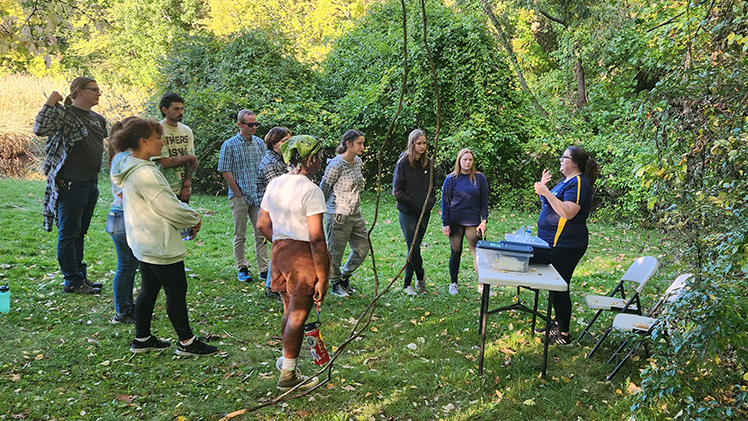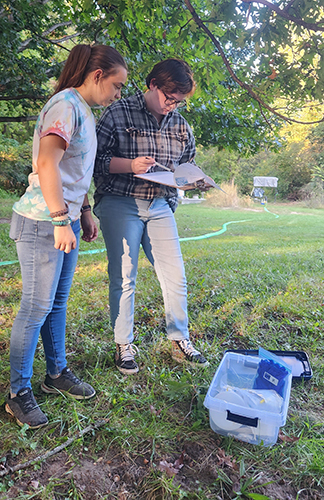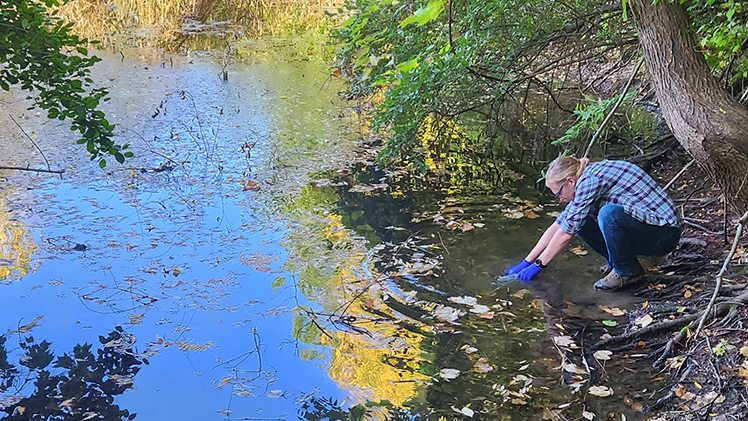Area high school teachers are researching the diversity of the microbiome of Lake Erie.
So are their teenage students. Some local fishing charter captains. Several firefighters with the Morin Point Fire Department in Erie, Mich.

Megan Ginther, a lab technician in Dr. Trisha Spanbauer’s lab at the UToledo Lake Erie Center, instructs members of the Society of Environmental Advocates on how to sample water for ERIeDNA at Stranahan Arboretum.
And, most recently, University of Toledo students with the Society of Environmental Advocates (SEA), who collected water samples during a field trip to the Stranahan Arboretum on Tuesday, Oct. 3.
They’ve all been deputized through ERIeDNA, a community-driven science program based out of Dr. Trisha Spanbauer’s lab at the UToledo Lake Erie Center. ERIeDNA invites volunteers of all ages to collect samples throughout the local watershed, and to join their professional counterparts in learning about the algae, bacteria and other microscopic organisms in local waters.
“I find that the local community is most affected by water quality issues in Lake Erie, but they’re often the least incorporated into active research,” said Megan Ginther, a lab technician who helped to get the program up and running last summer as an undergraduate student studying environmental sciences. “Bridging that knowledge gap between researchers and the public is one of the goals of ERIeDNA. The other is to move the community to action, so that they can also contribute to the restoration and stewardship of Lake Erie.”
ERIeDNA fits into a broader research initiative funded by the Ohio Sea Grant. Spanbauer, an assistant professor in the Department of Environmental Sciences, has been investigating how human shoreline activity impacts prokaryotes, microbial eukaryotes and photosynthetic algae in the western basin of Lake Erie.
These microbes play a vital role in the health of the whole ecosystem, she explained.

Alix Staley and Kaela Bartley of UToledo’s Society for Environmental Advocates fill out a metadata sheet while sampling water at the Stranahan Arboretum.
“They’re foundational to the food web. Most energy enters the system through photosynthesis, which is done by eukaryotic algae and cyanobacteria,” she said. “Both prokaryotes and eukaryotes are also really involved in cycling nutrients. And because they’re intimately connected to these biogeochemical processes, they can also indicate when a system is healthy or under stress.”
And that’s not to mention the harmful microbes already very familiar to those who live around the western basin of Lake Erie. Spanbauer also is looking at toxin producers like microcystis.
“Those are the ones to watch out for,” she said.
Since 2021 Spanbauer and researchers in her lab have collected samples at nine sites that run the gamut when it comes to “human shoreline activity.” Some are near agricultural and industrial areas near Toledo, others in wetlands like Old Woman Creek. Researchers also considered a variety of shoreline management techniques, like a seawall intended to combat erosion.
Spanbauer and the team passed water through a filter for each sample. Then from this filter, they extracted DNA. (ERIeDNA is a play on eDNA, short for environmental DNA, referring to samples collected indirectly from the environment rather than directly from an organism.) With this eDNA, they’ve been able to extrapolate information about the microbes that reside at each site.
They expect the data, which they’re now crunching, to offer insights into the resilience and vulnerability of the sampled ecosystems.
Meanwhile, ERIeDNA continues and expands the scope of their work.
Ginther, who coordinates the community program, said the lab has so far received 21 samples representing 12 sites throughout the watershed since ERIeDNA kicked off last summer, with more samples expected from students and teachers participating in Toledo Metropolitan Area Council of Governments (TMACOG)’s Student Watershed Watch.

Brendan Luurtsema, of UToledo’s Society for Environmental Advocates, collects a sample from one of the ponds at Stranahan Arboretum. SEA was there on Tuesday, Oct. 3, through ERIeDNA, a community-driven science program based out of Dr. Trisha Spanbauer’s lab at the UToledo Lake Erie Center.
Ginther instructs volunteers how to use a hand pump to pass water through a filter. Then they return the filters to the lab, where researchers extract the eDNA and send it to be sequenced at the University of Minnesota Genomics Center.
Ginther said the lab recently received its first data set from Minneapolis. They plan to share it in a publicly accessible database, in what she said is another key element of ERIeDNA.
“We want to return the data to the people, so they can see what’s in the water in the locations where they swim or fish or boat: What does the lower food web look like there?” she said.
Spanbauer and Ginther said they hope to continue to develop ERIeDNA.
“Lake Erie is such a valuable resource,” said Ginther, whose upbringing alongside it in Erie, Mich., inspired her interest in this work. “We want to get people involved in this research, teach them about the water quality issues and raise some awareness.”
For more information on ERIeDNA, email Ginther at Megan.Ginther@UToledo.edu or Trisha Spanbauer’s website.